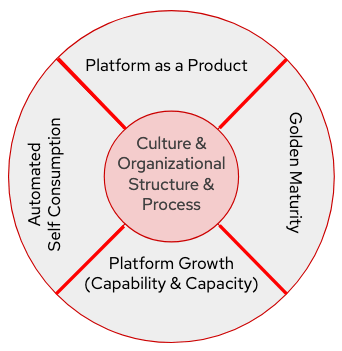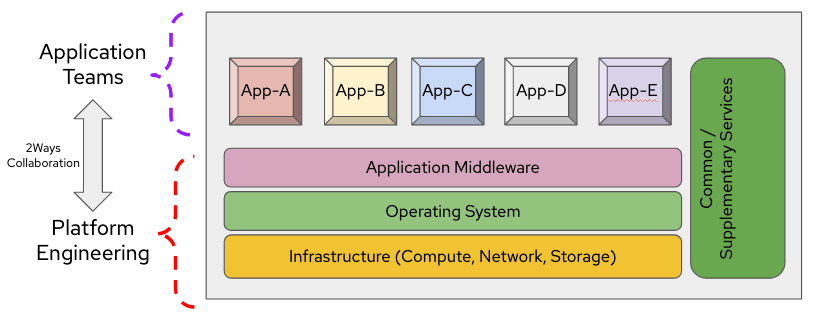TME service providers have adopted cloud-native architectures in an era of rapid digital transformations. Their virtualized network function (VNF) stacks, such as IP Multimedia Subsystem (IMS) and 5G Core, are constructed with microservices housed within containers managed and orchestrated by Kubernetes (K8s). This is the stage where platform engineering is evolving, with the incorporation of Internal Development Platforms (IDPs) taking center stage.
As enterprises grapple with the escalating demands for agile, scalable, and efficient software solutions, platform engineering is the backbone, ensuring a confluence of development, operations, and delivery processes. On the other hand, IDPs serve as the catalysts enabling rapid deployment and seamless management of applications in this cohesive setup.
This article dives deeper into this essential domain, elucidating platform engineering and explaining its advantages and potential pitfalls. Additionally, we'll explore the telecom service providers' pivotal decision in embracing this transformative approach, emphasizing the integration of Internal Development Platforms (IDPs).
What is platform engineering?
Platform engineering is a linchpin of efficiency and innovation in today's software development ecosystem. Here's a nuanced look at its critical components, now enhanced with IDPs:
- Platform as a Product: By spearheading the management of underlying infrastructure, platform engineering, coupled with IDPs, guarantees an optimized, reliable, and scalable environment akin to a robust tower's foundation that hosts myriad applications.
- Automation: Advocating a "code everything" philosophy, it facilitates swift, error-free deployments and operations, underlining the era where automation is indispensable.
- Growth and Scale: At its core, platform engineers craft a cohesive environment by integrating diverse tools and services, thus fostering seamless operations and synergies between various software components. IDPs serve as a conduit for this integration, promoting a harmonious co-existence of tools and services within the ecosystem. IDPs play a significant role here by providing a centralized platform for continuous integration and continuous delivery (CI/CD).
- Golden Maturity: By judiciously managing resources, platform engineering balances elasticity, efficiency, and performance, ensuring optimal utilization of resources without compromising industry regulations and policies. IDPs augment this by providing a standardized, automated platform for deploying and managing applications, thus ensuring regulatory compliance.

Figure-1 Key of Platform Engineering
What is IDP?
An Internal Development Platform (IDP) is a specialized environment that streamlines the process of developing, deploying, and managing applications within an organization. It abstracts and automates underlying infrastructure management tasks, providing developers with a simplified, self-service interface to deploy code and manage applications across various environments (e.g., development, staging, production).
IDPs are customized to meet an organization's specific needs, incorporating the necessary tooling and compliance requirements to ensure developers can focus on coding while adhering to organizational standards and practices.
Benefits of platform engineering with IDP
The accelerating pace of digital transformation in the telecom sector significantly underpins the necessity for robust, scalable, and efficient platform engineering solutions. Incorporating Internal Development Platforms (IDPs) within this realm amplifies the advantages manifold, elevating operational performance and catalyzing innovation to meet the dynamic demands of consumers and regulatory frameworks.

Figure-2 App-Team vs Platform-Team Interaction and Role Scopes
Critical benefits of platform engineering enhanced by IDPs
Efficiency and cost-effectiveness:
- Operational efficiency: Both platform engineering and IDPs streamline the deployment and management of telecom services, minimizing operational overhead.
- Cost reduction: Both automate many manual operations, optimizing resource management and significantly reducing operational and capital expenditures.
Scalability and flexibility:
- Seamless scalability: The modular nature of platform engineering, enriched by IDPs, facilitates effortless scaling of operations to meet fluctuating demand.
- Infrastructure flexibility: The combination allows for a seamless integration with diverse infrastructure setups, catering to varying operational needs.
Reliability and availability:
- High availability: Ensures continuous service availability, even under high load during peak usage times.
- Disaster recovery: Provides integrated disaster recovery capabilities to ensure quick service restoration, minimizing downtime.
Innovation and speed to market:
- Accelerated deployment: IDPs enhance the automation of deployment pipelines, significantly quickening the time-to-market for new telecom services.
- Fostering innovation: The collaborative environment fostered by IDPs and platform engineering enables rapid adaptation to technological advancements and market trends.

Figure-3 NxOps Impact Domains
Compliance and security:
- Enhanced security: Incorporates robust security measures at every layer to safeguard sensitive data.
- Compliance management: Streamlines adherence to evolving regulatory requirements, minimizing non-compliance risks.
Improved customer satisfaction:
- Enhanced service quality: Assures high availability and reliability, thus improving service quality and customer satisfaction.
- Better customer experience: The rapid deployment of new features enriches the customer experience, cultivating long-term customer loyalty.
Insight and analytics:
- Real-time monitoring: Facilitates real-time monitoring of telecom services, delivering valuable insights for proactive issue resolution.
- Predictive analytics: Aids in predicting user behavior and trends, contributing to informed planning and resource allocation.
Developer productivity and collaboration:
- Developer efficiency: IDPs provide a self-service interface, freeing developers from infrastructure complexities and focusing on code deployment.
- Enhanced collaboration: Foster efficient collaboration among development, operations, and security teams, promoting a harmonious DevOps and DevSecOps culture.
Continuous Integration/Continuous Deployment (CI/CD) enablement:
- CI/CD integrations: IDPs come with built-in or easily integrable CI/CD pipelines, which are fundamental for modern platform engineering, facilitating continuous integration, testing, and deployment of applications.
Potential downfalls and challenges
While platform engineering heralds a host of advantages, especially for telecom service providers striving for digital transformation, addressing the potential pitfalls and challenges that could arise along the journey is imperative. Here are some critical considerations:
- Multi-faceted complexity: The orchestration of meshing various components and integrations in a telecom network can introduce complexity. This could potentially escalate error rates and downtime, necessitating meticulous planning and a well-structured execution strategy.
- Upfront investment: The initial setup requires a substantial investment in skilled personnel and infrastructure. A thoughtful resource allocation and management approach is crucial to ensure the transition stays within the telecom provider's resources.
- Collaboration hurdles: Without judicious planning and execution, a siloed environment can be fostered that impedes team collaboration and communication. This can curtail the seamless flow of information and ideas, which is vital for innovative service delivery in the telecom sector.
- Legacy system challenges: Telecom providers often have to grapple with legacy systems, which can pose significant integration challenges. This includes compatibility issues and potential service disruptions, underscoring the need for a phased and well-planned transition strategy.
- Compliance navigation: The telecom sector is heavily regulated, and ensuring compliance with existing and evolving regulatory norms is non-negotiable. Meticulous planning and foresight are required to navigate the delicate regulatory compliance path while adopting platform engineering practices.
Wrap up
Platform engineering emerges as a cornerstone in the modern software delivery paradigm, especially amid the rapid digital transformation sweeping across the telecom sector. By aligning closely with Site Reliability Engineering (SRE) and DevOps practices, it propels a transformative approach that nurtures innovation, efficiency, and a consistent delivery mechanism, fostering a conducive environment for telecom service providers to thrive.
Integrating Internal Development Platforms (IDPs) within the telecom infrastructural framework accentuates the essence of platform engineering, facilitating a self-service container platform experience. This integration augments development efficiency and positions telecom providers at the vanguard of delivering agile, scalable, and reliable services in a competitive market landscape.
While the journey is laden with potential challenges like complex orchestration, resource intensiveness, and integration hurdles, especially with legacy systems, the strategic adoption of platform engineering practices promises a slew of benefits. These encompass enhanced operational efficiency, reduced operating and capital expenditures, seamless scalability, and a robust security posture.
In taking this strategic leap, telecom service providers are investing in a future-ready framework that promises not only to meet the escalating demands of today but also to adapt to the unforeseen demands of tomorrow rapidly. The road ahead may demand meticulous planning, resource allocation, and a well-structured execution strategy to mitigate potential pitfalls. Yet, the promise of enhanced scalability, faster innovation, and cost-effectiveness makes platform engineering a compelling proposition.
By astutely navigating the challenges and leveraging the myriad benefits, telecom service providers are positioning themselves for operational excellence and setting the stage for pioneering the next wave of innovations in the telecom realm. The expedition towards a platform-engineered telecom infrastructure is not just a technical transition but a strategic initiative poised to redefine telecom service providers' operational and innovative horizons.
About the authors
Fatih, known as "The Cloudified Turk," is a seasoned Linux, Openstack, and Kubernetes specialist with significant contributions to the telecommunications, media, and entertainment (TME) sectors over multiple geos with many service providers.
Before joining Red Hat, he held noteworthy positions at Google, Verizon Wireless, Canonical Ubuntu, and Ericsson, honing his expertise in TME-centric solutions across various business and technology challenges.
With a robust educational background, holding an MSc in Information Technology and a BSc in Electronics Engineering, Fatih excels in creating synergies with major hyperscaler and cloud providers to develop industry-leading business solutions.
Fatih's thought leadership is evident through his widely appreciated technology articles (https://fnar.medium.com/) on Medium, where he consistently collaborates with subject matter experts and tech-enthusiasts globally.
Volker Tegtmeyer develops content strategies that show how Red Hat solutions can help telecommunications service providers meet their business and technology challenges. Solutions that help service providers in their digital transformation and as they evolve from telco to techco. New technologies cover broad areas from 5G, AI/ML, telco cloud, automation to new solutions that help tackling sustainability goals. Volker has more than 20 years of experience in the telecommunications industry having previously worked in various roles at Siemens, Cisco and Akamai.
Browse by channel
Automation
The latest on IT automation for tech, teams, and environments
Artificial intelligence
Updates on the platforms that free customers to run AI workloads anywhere
Open hybrid cloud
Explore how we build a more flexible future with hybrid cloud
Security
The latest on how we reduce risks across environments and technologies
Edge computing
Updates on the platforms that simplify operations at the edge
Infrastructure
The latest on the world’s leading enterprise Linux platform
Applications
Inside our solutions to the toughest application challenges
Original shows
Entertaining stories from the makers and leaders in enterprise tech
Products
- Red Hat Enterprise Linux
- Red Hat OpenShift
- Red Hat Ansible Automation Platform
- Cloud services
- See all products
Tools
- Training and certification
- My account
- Developer resources
- Customer support
- Red Hat value calculator
- Red Hat Ecosystem Catalog
- Find a partner
Try, buy, & sell
Communicate
About Red Hat
We’re the world’s leading provider of enterprise open source solutions—including Linux, cloud, container, and Kubernetes. We deliver hardened solutions that make it easier for enterprises to work across platforms and environments, from the core datacenter to the network edge.
Select a language
Red Hat legal and privacy links
- About Red Hat
- Jobs
- Events
- Locations
- Contact Red Hat
- Red Hat Blog
- Diversity, equity, and inclusion
- Cool Stuff Store
- Red Hat Summit


